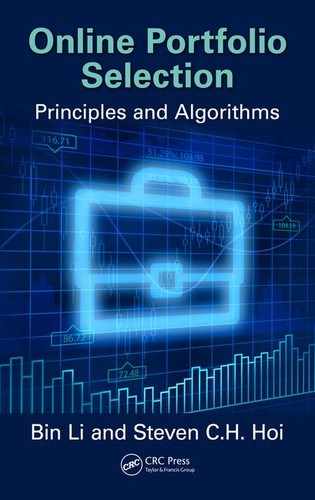
Chapter 3
Benchmarks
3.1 Buy-and-Hold Strategy
The most common baseline is the Buy-and-Hold (BAH) strategy, in which one invests
wealth among the market with an initial portfolio of b
1
and holds the portfolio till the
end. The manager only buys the assets at the beginning of the first period and does not
rebalance in subsequent periods, while the portfolio holdings are implicitly changed
following the market fluctuations. In particular, at the end of period t, the portfo-
lio holding becomes
b
t
x
t
b
t
x
t
, where
denotes the element-wise product.
∗
BAH’s
final cumulative wealth is the initial portfolio-weighted average of individual asset
returns, that is,
S
n
(BAH(b
1
)) = b
1
·
n
t=1
x
t
,
where b·x denotes the inner product b
x. The BAH strategy with uniform portfolio
b
1
=
1
m
,...,
1
m
is referred to as the uniform BAH strategy, which is usually adopted
as a market strategy to produce a market index.
†
3.2 Best Stock Strategy
Another common benchmark is the Best Stock (Best) strategy, which is a special BAH
strategy that invests all capital on the best stock in hindsight. Its initial portfolio b
0
can
be calculated as, b
0
= arg max
b∈
m
b ·
n
t=1
x
t
, which is thus a hindsight strategy.
The strategy’s final cumulative wealth equals
S
n
(Best) = max
b∈
m
b ·
n
t=1
x
t
= S
n
(BAH(b
0
)).
∗
For example, assuming two assets with price relative vectors (2, 1) and the portfolio at the beginning of
a periodis (0.5, 0.5), then the actual weights at the end of the period becomes
(0.5×2,0.5×1)
0.5×2 +0.5×1
= (0.67, 0.33).
†
Market index can also be calculated using other methods, such as capitalization weighted index and
market share weighted index.
21
T&F Cat #K23731 — K23731_C003 — page 21 — 9/26/2015 — 8:11

22 BENCHMARKS
3.3 Constant Rebalanced Portfolios
One challenging benchmark is the Constant Rebalanced Portfolios (CRP) strategy,
which rebalances to a fixed portfolio b every period.
∗
In particular, the portfolio
strategy can be represented as b
n
1
={b, b,...,b}, in which b is a predefined portfolio.
Thus, CRP’s final cumulative portfolio wealth can be calculated as
S
n
(CRP(b)) =
n
t=1
b
x
t
.
One special CRP with uniform portfolio b =
1
m
,...,
1
m
is named as Uniform Con-
stant Rebalanced Portfolios (UCRP). Another special CRP is the optimal offline
†
CRP strategy, whose portfolio can be calculated as
b
= arg max
b
n
∈
m
S
n
(CRP(b)) = arg max
b∈
m
n
t=1
b
x
t
,
which is convex and can be efficiently solved. The CRP with b
is denoted as Best
Constant Rebalanced Portfolios (BCRPs), which achieve a final cumulative wealth as
S
n
(BCRP) = max
b∈
m
S
n
(CRP(b)) = S
n
(CRP(b
))
Note that BCRP is a hindsight strategy, which can only be calculated with com-
plete market sequences. Cover (1991) proved that BCRP is the best strategy in an
independent and identically distributed (i.i.d.) market and showed its benefits as a
target, that is, BCRP exceeds the Best Stock strategy, Value Line Index (geometric
mean of asset returns), and Dow Jones Index (arithmetic mean of asset returns, or
BAH). In addition, BCRP is invariant under permutations of market sequence, that
is, it does not depend on the order in which x
1
, x
2
,...,x
n
occur.
One desired theoretical result for an OLPS algorithm is universality (Cover 1991;
Ordentlich 2010). An algorithm Alg is universal if the average (external) regret
(Stoltz and Lugosi 2005; Blum and Mansour 2007) for n periods asymptotically
approaches 0, that is,
1
n
regret
n
(Alg) =
1
n
(log S
n
(BCRP) −log S
n
(Alg))
n→∞
−−− → 0. (3.1)
In other words, for an arbitrary sequence of price relatives, a universal algorithm
asymptotically approaches the same exponential growth rate as the BCRP strategy.
Since CRP rebalances to a fixed portfolio each period, its frequent transactions
will incur high transaction costs. Helmbold et al. (1998) proposed a Semi-Constant
Rebalanced Portfolio, which rebalances on selected periods rather than every period.
∗
CRP differs from BAH as the former actively rebalances to a predefined portfolio for every period,
while the latter does not rebalance during the entire trading period. However, the portfolio holding of BAH
passively changes as the stock prices fluctuate.
†
Contrary to the online case, offline assumes that all price relatives over the n periods are available.
T&F Cat #K23731 — K23731_C003 — page 22 — 9/26/2015 — 8:11
..................Content has been hidden....................
You can't read the all page of ebook, please click here login for view all page.
